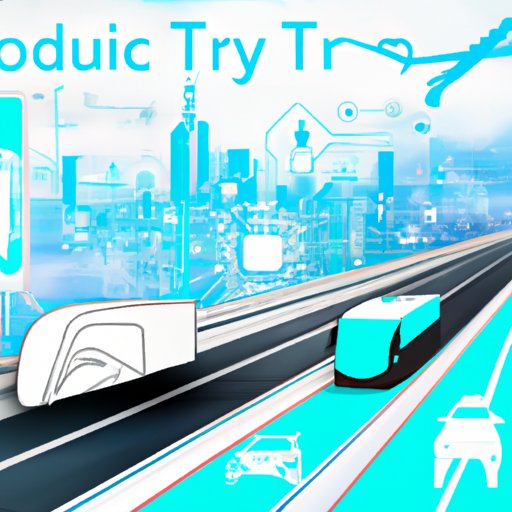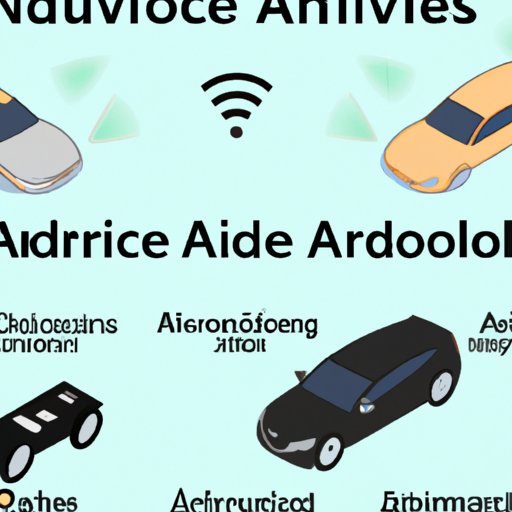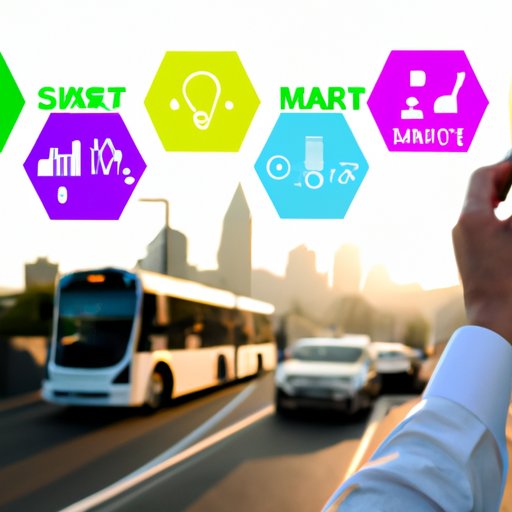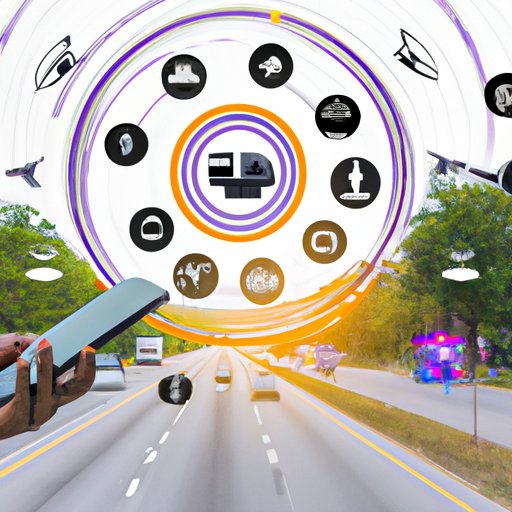Introduction
Technology has revolutionized many aspects of our lives, from communication to healthcare, and transportation is no exception. In recent years, the use of technology in transportation has grown exponentially, with the emergence of autonomous vehicles, ride-sharing services, and smart mobility solutions. But what exactly is technology in transportation?
In a nutshell, technology in transportation refers to the use of technological tools, such as sensors, artificial intelligence (AI), and blockchain, to improve the safety, efficiency, and convenience of transportation systems. This includes everything from driverless cars and delivery drones to smart road networks and real-time traffic information.
In this article, we’ll explore the role of technology in modern transportation, its impact on the future of the industry, and how it is changing the way we travel. We’ll also take a look at some emerging technologies in transportation, analyze the pros and cons of using technology in transportation, and examine the potential of autonomous vehicle technology and smart mobility solutions.
Exploring the Role of Technology in Modern Transportation
Technology has had a major impact on the transportation industry, from making roads safer to improving the efficiency of public transit systems. According to a study by the World Bank, “The deployment of advanced technologies, such as IoT [Internet of Things], big data analytics, and autonomous vehicles, can help reduce accident rates, improve the efficiency of transport systems, and reduce fuel cost, among other benefits.”
Impact of Technology on Safety and Efficiency
One of the most significant impacts of technology on transportation is its ability to improve safety. Innovations such as collision avoidance systems, lane departure warnings, and automatic emergency braking have helped reduce the number of accidents on the road. Additionally, technologies such as connected vehicle systems and smart traffic lights can help reduce congestion and improve the flow of traffic.
In addition to improving safety, technology has also had a major impact on the efficiency of transportation systems. Automation has enabled companies to reduce labor costs and increase productivity, while GPS tracking systems have allowed for better route optimization and improved fleet management. Furthermore, the use of AI and machine learning has enabled companies to make better decisions based on real-time data.
Benefits of Using Technology in Transportation
The use of technology in transportation offers numerous benefits, including improved safety, increased efficiency, and lower costs. For example, according to a report by the Boston Consulting Group, “Autonomous vehicles have the potential to reduce costs by up to 90 percent, improve safety by eliminating human error, and reduce emissions by up to 60 percent.” Additionally, the use of AI and machine learning can enable companies to better manage their fleets and optimize routes, resulting in faster transit times and reduced fuel consumption.
Challenges Faced by the Industry Due to Technological Advances
While technology has had a positive impact on the transportation industry, it has also posed some challenges. For example, the introduction of autonomous vehicles has raised concerns about job security, as well as legal and ethical issues. Additionally, the rapid pace of technological advancement has made it difficult for companies to keep up with the latest trends, which can lead to a lack of innovation and missed opportunities.

The Impact of Technology on the Future of Transportation
As technology continues to advance, it is transforming the way we travel. From autonomous vehicles to smart mobility solutions, the future of transportation is being shaped by innovative technologies that are redefining the way we move people and goods.
Autonomous Vehicles and Their Potential Impact on Transportation
Autonomous vehicles are one of the most talked-about technologies in transportation today. These self-driving vehicles have the potential to revolutionize the industry, reducing costs, improving safety, and enabling more efficient transportation networks. Additionally, they could open up new business opportunities, such as autonomous ride-hailing services and delivery robots.
Emergence of Smart Mobility Solutions
Smart mobility solutions are another area where technology is having a major impact on the future of transportation. These solutions, which range from apps to sensors, can help reduce traffic congestion, improve the efficiency of public transit systems, and make cities more livable. Additionally, they can provide valuable insights into how people move around their cities, enabling governments and businesses to better plan for the future.
Potential Changes in Transportation Infrastructure
Finally, technology is also having an impact on the infrastructure of transportation networks. As autonomous vehicles become more common, roads will need to be redesigned to accommodate them, and new technologies, such as 5G networks and connected vehicle systems, will need to be implemented. Additionally, the rise of electric vehicles will require changes in the way energy is sourced and distributed.
Examining How Technology is Changing the Way We Travel
Technology is not only transforming the way we move people and goods, but also the way we travel. From ride-hailing services to mobile applications, technology is making it easier than ever to get around.
Rise of Ride-Hailing Services Such as Uber and Lyft
Ride-hailing services, such as Uber and Lyft, have revolutionized the way we travel. These services make it easy to book a ride, track your driver, and pay for your fare, all from your smartphone. Additionally, these services offer discounted fares and allow passengers to share rides, making them a cost-effective alternative to traditional taxi services.
Increased Use of Mobile Applications to Book Rides and Track Transportation
In addition to ride-hailing services, mobile applications are also playing an increasingly important role in the way we travel. From booking flights to tracking buses and trains, there are now a variety of apps that make it easier to plan and manage trips. Additionally, these apps often offer features such as real-time updates and ticketing options, making it easier to stay informed and organized while on the go.
Integration of AI Into the Transportation Industry
Artificial intelligence (AI) is another technology that is transforming the transportation industry. From predictive analytics to route optimization, AI is being used to improve the efficiency of transportation networks and enable smarter decision-making. Additionally, AI-powered chatbots are being used to provide customers with personalized service and guidance, making it easier for them to find the information they need.
A Look at Emerging Technologies in Transportation
From autonomous vehicles to delivery drones, there are a number of emerging technologies that are poised to revolutionize the transportation industry. Let’s take a closer look at some of these technologies and their potential impacts.
Delivery Drones and Their Potential to Revolutionize Freight Transportation
Delivery drones are unmanned aerial vehicles that are being used to deliver packages and goods. These drones have the potential to revolutionize freight transportation, enabling faster and more efficient delivery of goods. Additionally, they could reduce costs and enable companies to reach remote areas that may otherwise be inaccessible.
Autonomous Ships and the Possibilities They Offer
Autonomous ships are another emerging technology that could have a major impact on the transportation industry. These vessels, which are equipped with sensors and AI, can navigate the seas without the need for a human crew. This could enable faster, cheaper, and more efficient transportation of goods, as well as reduce the risk of accidents due to human error.
Use of Blockchain Technology in the Transportation Industry
Blockchain technology is also being used in the transportation industry. This technology can be used to track shipments, store data, and facilitate payments, making it easier to manage logistics and supply chains. Additionally, it could be used to create secure digital identities for drivers and passengers, helping to ensure the safety and privacy of users.

Analyzing the Pros and Cons of Technology in Transportation
While technology in transportation has many benefits, there are also some potential drawbacks. Let’s take a look at some of the advantages and disadvantages associated with the use of technology in transportation.
Advantages of Using Technology in Transportation
The use of technology in transportation has numerous advantages, including improved safety, increased efficiency, and lower costs. Additionally, it can enable companies to better manage their fleets and optimize routes, resulting in faster transit times and reduced fuel consumption. Finally, technologies such as AI can help companies make better decisions based on real-time data.
Disadvantages Associated with the Use of Technology in Transportation
Despite the many benefits of using technology in transportation, there are also some potential drawbacks. For example, the rapid pace of technological advancement can make it difficult for companies to keep up with the latest trends, leading to a lack of innovation and missed opportunities. Additionally, the introduction of autonomous vehicles has raised concerns about job security, as well as legal and ethical issues.

An Overview of Autonomous Vehicle Technology
Autonomous vehicles are one of the most talked-about technologies in transportation today. These self-driving vehicles have the potential to revolutionize the industry, but there are still many challenges that need to be addressed before they can be widely adopted. Let’s take a look at some of the different types of autonomous vehicles and the regulations surrounding them.
Different Types of Autonomous Vehicles
Autonomous vehicles come in a variety of shapes and sizes, ranging from cars and trucks to buses and vans. Additionally, there are different levels of autonomy, ranging from Level 1, which requires the driver to remain in control at all times, to Level 5, which is fully autonomous and requires no human intervention.
Challenges Posed by Autonomous Vehicle Technology
Despite the potential of autonomous vehicles, there are still many challenges that need to be addressed. These include technical challenges, such as ensuring the reliability and accuracy of sensors and algorithms, as well as regulatory challenges, such as creating laws and guidelines to ensure the safety of passengers and pedestrians.
Regulations Surrounding Autonomous Vehicles
Finally, there are a number of regulations that need to be in place before autonomous vehicles can be widely adopted. These include rules and regulations governing the testing and deployment of autonomous vehicles, as well as laws governing liability and insurance.

Investigating the Potential of Smart Mobility Solutions
Smart mobility solutions are becoming increasingly popular as cities around the world strive to become more livable and sustainable. Let’s take a look at some examples of existing smart mobility solutions and the benefits and challenges they pose.
Examples of Existing Smart Mobility Solutions
Smart mobility solutions range from apps to sensors and can be used to reduce traffic congestion, improve the efficiency of public transit systems, and make cities more livable. Examples of existing smart mobility solutions include bike-sharing programs, car-sharing services, real-time traffic information, and smart parking solutions.
Benefits of Implementing Smart Mobility Solutions
The implementation of smart mobility solutions can provide numerous benefits, including improved safety, increased efficiency, and lower costs. Additionally, these solutions can provide valuable insights into how people move around their cities, enabling governments and businesses to better plan for the future.
Challenges Posed by Smart Mobility Solutions
Despite the potential benefits of smart mobility solutions, there are also some challenges that need to be addressed. For example, the implementation of these solutions can be expensive and time-consuming, and there are privacy and security concerns that need to be taken into account. Additionally, there is still a lack of understanding of how these solutions can be effectively implemented.
Conclusion
Technology has had a major impact on the transportation industry, from making roads safer to improving the efficiency of public transit systems. From autonomous vehicles to smart mobility solutions, technology is transforming the way we travel and shaping the future of transportation. Additionally, it is offering numerous benefits, such as improved safety, increased efficiency, and lower costs. However, there are also some potential drawbacks, such as job insecurity and privacy concerns. As technology continues to evolve, it will be interesting to see how it further transforms the transportation industry.
(Note: Is this article not meeting your expectations? Do you have knowledge or insights to share? Unlock new opportunities and expand your reach by joining our authors team. Click Registration to join us and share your expertise with our readers.)
